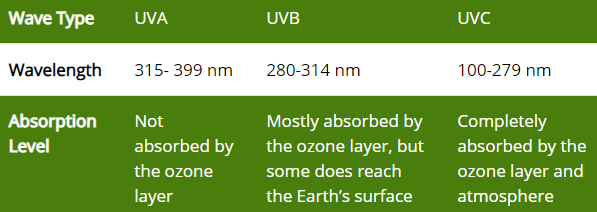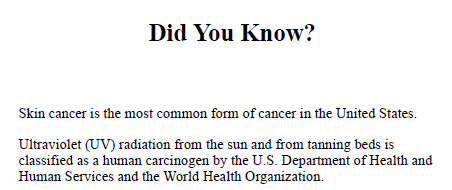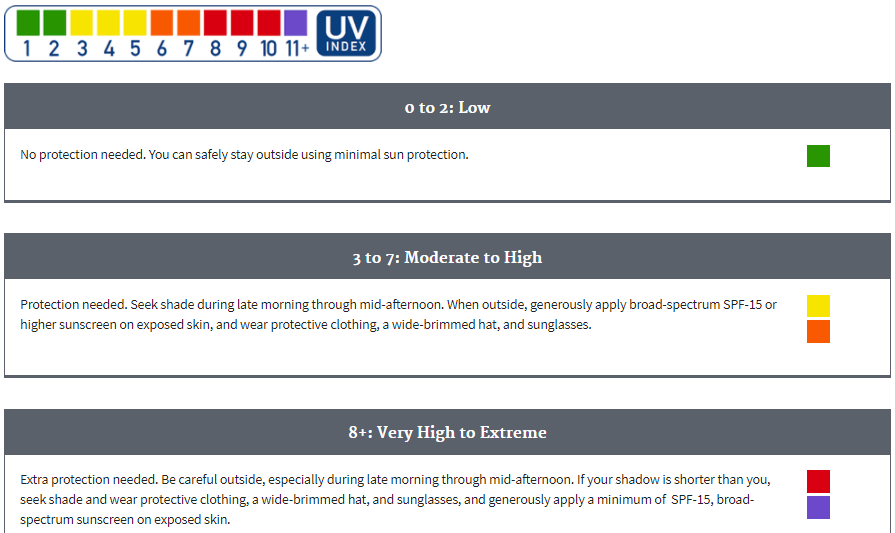Ultraviolet (UV) radiation is a form of non-ionizing radiation emitted by the sun and artificial sources. Artificial sources that emit UV radiation include tanning beds, mercury vapor lighting, halogen, fluorescent and incandescent lights, and some types of lasers.
While it has some benefits for people, including the creation of Vitamin D, it also can cause health risks. Understanding these risks and taking sensible precautions will help you enjoy the sun while reducing your chances of sun-related health problems.
UV Radiation
UV radiation includes three primary types: ultraviolet A (UVA), ultraviolet B (UVB), and ultraviolet C (UVC). These groups are based on the measure of their wavelength, which is measured in nanometers (nm= 0.000000001 meters or 1×10-9 meters).

The earth’s ozone layer absorbs all the UVC and most UVB radiation, so nearly all the ultraviolet radiation received on Earth is UVA. Even though UVA radiation is weaker than UVB, it penetrates deeper into the skin and is more constant throughout the year.
Benefits of UV Radiation
Beneficial effects of UV radiation include the production of vitamin D, a vitamin essential to human health. Vitamin D helps the body absorb calcium and phosphorus from food and assists bone development. The World Health Organization (WHO) recommends 5 to 15 minutes of sun exposure 2 to 3 times a week.
However, the amount of UV exposure needed to obtain a benefit depends on several factors: the amount of vitamin D in your diet, skin color, sunscreen use, clothing, where you live (latitude and altitude), time of day, and time of year.
Dangers of UV Radiation
While some exposure to sunlight can be enjoyable, too much can be dangerous. Overexposure to ultraviolet (UV) radiation from the sun can result in a painful sunburn. It can also lead to more severe health problems, including skin cancer, premature aging of the skin, cataracts and other eye damage, and immune system suppression. Occupations such as environmental field work and construction are at a higher risk of overexposure to UV radiation. Implementing the use of a Job Safety Analysis or Job Hazard Analysis will remind your employees to take preventative measures against the harmful effects of sun exposure.
Most people are not aware that skin cancer, while largely preventable, is the most common form of cancer in the United States. More than one million cases are reported annually.

By following some simple steps, you can still enjoy your time in the sun and protect yourself from sun exposure.
Protect yourself and others from UV Radiation
The United States Environmental Protection Agency (EPA) article, ‘Action Steps for Sun Protection’ lists the following preventative measures you can do to prevent cancers, premature aging of the skin, the development of cataracts, and other harmful effects from UV radiation.
Do Not Burn
Sunburns significantly increase one’s lifetime risk of developing skin cancer, especially for children.
Generously Apply Sunscreen
Use about one ounce to cover all exposed skin 20 minutes before going outside. Sunscreen should have a Sun Protection Factor (SPF) of at least 15 and provide protection from both ultraviolet A (UVA) and ultraviolet B (UVB) rays. Reapply every two hours, even on cloudy days, and after swimming or sweating.
Wear Protective Clothing
Such as a long-sleeved shirt, pants, a wide-brimmed hat, and sunglasses.
Seek Shade
Seek shade between 10 a.m. and 4 p.m. because that’s when the sun’s UV rays are strongest.
Use Extra Caution Near Water, Snow, and Sand
Water, snow, and sand reflect the sun’s rays, which can increase your chance of sun exposure.
Avoid Sun Tanning and Tanning Beds
UV light from tanning beds and the sun causes skin cancer and wrinkling.
Check the UV Index
The UV Index provides important information to help you plan your outdoor activities in ways that prevent sun overexposure.

Sun Safety Tips for Employers
The Occupational Safety and Health Administration (OSHA) requires employers to provide safe and healthy working conditions for employees. A great way to remind your employees of the protective measures they can follow to prevent sun exposure is through the use of a Job Safety Analysis or Job Hazard Analysis.
Employers can implement the following measures to protect their employees from sun exposure on the job:
- Encourage sun safety among your employees and provide sun protection when possible.
- Use tents, shelters, and cooling stations at worksites.
- Schedule breaks in the shade and remind workers to reapply sunscreen throughout their shifts.
- Create work schedules that minimize sun exposure. For example, rotate workers to reduce their sun exposure.
- Include sun-safety information in workplace wellness programs.
- Train workers about the risks of exposure to UV rays and the symptoms of overexposure using a Job Safety Analysis or Job Hazard Analysis.
As you prepare your next Job Safety Analysis (JSA) or Activity Hazard Analysis (AHA) for outdoor work, sun exposure may be an essential part of your hazard assessment. A JSA worksheet will help workers identify UV hazards and determine what controls and safety procedures can be implemented. For JSA software to aid in creating JSA worksheets and activity hazard analysis forms, visit www.JSABuilder.com.
Follow us on LinkedIn and Twitter @JSABuilder, where we post and Tweet about Health and Safety, provide Safety tips, and updates on current Health and Safety topics.
Images, links, brands discussed or displayed in this article are not endorsements or recommendations. They are for illustration of various products and types of products. JSABuilder does not recommend or express any opinion as to the applicability to any given use case or job hazards.